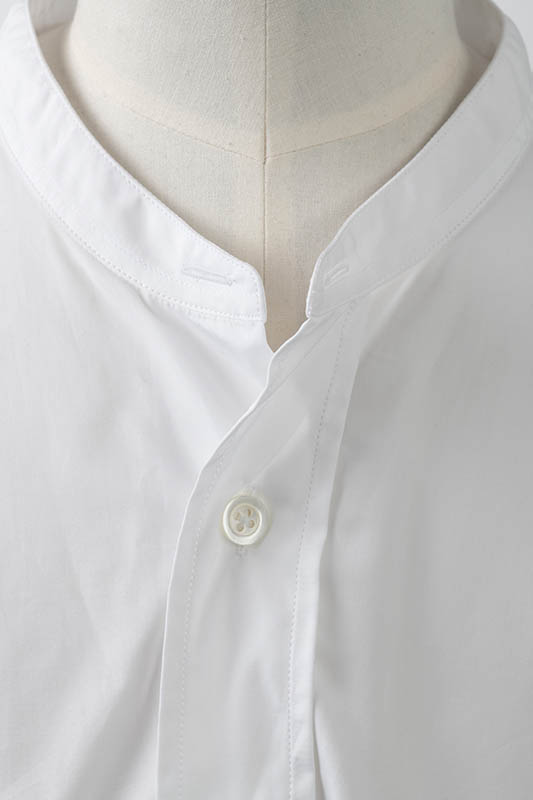
Kyoto Seika University, Assembly Hour Open Seminars
Margaret Howell and Kaikado
A Way of Changing by Remaining Unchanged—Making that Incorporates Time
On February 11, 2021, Kyoto Seika University held the Assembly Hour Open Seminar, “Margaret Howell and Kaikado, A Way of Changing by Remaining Unchanged—Making that Incorporates Time.” The clothing of Margaret Howell, which marked its 50th anniversary in 2020, has brought joy to people who wear the brand’s garments due to its authentic design, functionality, and comfort. By understanding the core of her design and exploring the reasons why it has been cherished by people over time, we hope to reflect on the meaning of a timeless design that has endured for 50 years. With this as its purpose, the lecture included a talk by Kenichi Ikeda, who has been responsible for designing Margaret Howell’s clothing for 19 years, and a dialogue between Ikeda and Takahiro Yagi, the sixth-generation successor of the tea caddy maker Kaikado, which is trying to open up a new field in manufacturing while simultaneously preserving traditions in Kyoto. The lecture served as a valuable opportunity to consider the essence of making from various angles. Here, we present the highlights of the lecture.
Program
Session 1: Lecture “Margaret Howell’s Creation”
Kenichi Ikeda (CEO, TSI Inc. (formerly anglobal Inc.): Director and Director of Design, Margaret Howell)
Session 2: Dialogue
Kenichi Ikeda and Takahiro Yagi (The sixth-generation of Kaikado: Special Research Fellow, The Center for Innovation in Traditional Industries)
Session 3: Message from Margaret Howell to the Students of Kyoto Seika University
Moderator: Mariko Nishitani (Visiting Professor, Department of Popular Culture at Kyoto Seika University)
Greeting
MH50 - 50 YEARS OF DESIGN
*Closed Captions available in English, French, Italian, and Japanese.
Nishitani: Before commencing the lecture, I would like first to invite you to watch a video that was created to commemorate the 50th anniversary of Margaret Howell. In collaboration with the filmmaker Emily Richardson, Margaret Howell, who says, “It’s hard to explain my inspiration in words,” made this short film about her values and ideas in relation to making. There is a scene in the video in which Margaret takes out an old picture of her family from a box, and this reminded me of a photography book by August Sander titled People in the 20th Century. I couldn’t help but remember the beauty of everyday clothes worn by townspeople in the book, and I was moved to think that here is a person who continues to make this kind of clothing. The essence of Margaret’s making is condensed in the video, so I hope you enjoy watching it.
Mariko Nishitani
After joining Bunka Publishing Bureau in 1974, Nishitani worked in the editorial department of “Soen” and “High Fashion.” She worked at its Paris branch office from 1980 to 1982. Since retiring in 2011, she has been active as an editor and writer with a focus on fashion. Nshitani’s books include Fashion has Begun to Talk (Film Art Inc., 2011) and Relativity—the Theory of Comme des Garcons (Film Art Inc., 2012).
Session 1
Lecture: “Margaret Howell’s Creation”
Kenichi Ikeda
Kenichi Ikeda (Design Director, Margaret Howell, TSI Inc./Director, MARGARET HOWELL LTD.)
After graduating from Apparel Design Department at Bunka Fashion College, Ikeda joined anglobal Inc. in 2002 (presently TSI Inc.) where he was responsible for designing Margaret Howell’s men’s clothing line. In 2007, Ikeda became the Director of Design. Since 2014, he has also been the Director of MARGARET HOWELL LTD. He continues to work as a men’s clothing designer.
Clothing designer, not fashion designer
Ikeda: Today, I would like to talk a little about what I learned and felt through working with Margaret for 19 years, in addition to her philosophy of making. First, a person who designs clothes is often called a fashion designer in Japan, but Margaret and we designers at Margaret Howell work as clothing designers, not fashion designers. The term “clothing designer” refers to a designer who makes clothes, which is one of the three major elements of life; food, clothing, and shelter. Clothing cannot be separated by the seasons as defined by the fashion industry. Rather, it continues to exist through the life of the wearer. Clothing provides comfort to people in their daily activities and does not age even when worn every day. Unswayed by fashion trends, clothing is what people want to wear the following year. By adding accents that are lightly playful yet not eccentric using materials and colors in balance with the season, we help people feel the enrichment and joy of wearing clothes. In this way, we create a wonderful enduring style. This is how we define clothing design.

On the other hand, although I don’t consider a fashion designer as something negative, it refers to the work of creating a collection themed solely around a single season. Fashion is constantly changing and goes in and out of style over the years. Such garments can feel old, embarrassing, or outdated when worn in the next season, and at times they may stand out more than the wearer due to the strong message the clothes carry. That’s very different from the direction we take in our design. Our role as clothing designers is to design what is needed in everyday life from the perspective of people wearing clothing, not the other way around.
With the right materials, there is no need for unnecessary design
Now I will move on to discuss what we think is important in designing. We value fabric and quality the most. Margaret often says, “If you have the right materials, there is no need for unnecessary design.” Ideally, clothing is made using the right materials and equipped with necessary functions without superfluous details. We can also use the terms “function and utility” to express this way of thinking. It is only after pursuing this ideal to the end that beautiful forms emerge. Quality here means that clothing is carefully made and tailored. Lining, which isn’t seen from the front, should also be tailored beautifully. Stitching on a shirt or jacket, for example, also needs to please the eye. As stitching is called “the handling of a needle” in our industry, it’s important that it looks neat. Clothing made with the right materials and quality can be worn for a long time with a sense of attachment, and this logic corresponds to today’s idea of sustainable fashion. If clothes can be worn forever without being thrown away or recycled, that would be the most sustainable form of fashion, wouldn’t you agree? By wearing clothes over a long period of time, the changes that occur on the clothing become part of the wearer’s personality, which deepens the sense of attachment. The right fabric and clear quality are indispensable in making reliable garments, and we always cherish them when designing.
Creating “newness” with a method of making and balance without changing materials
One of the characteristics of Margaret Howell’s creation is that we continue to use the same favored materials. Since Margaret is from England, she loves British manufacturing, and she has persistently used fabrics such as Harris tweed, Scottish cashmere, Irish linen for 50 years up until the current season. Each has a different texture, hardness, weight, and so on, but most materials remain almost the same. Although the materials we use have not changed, the methods of making products have. In the past, let’s say 50 years ago, we added shoulder pads and used a wide jacket lapel as well as slightly squeezed waistline, but now we design a relaxed oversized silhouette with a narrow lapel. Even with the same materials, we always try to propose newness by designing details, by changing a button size according to the mood and inspiration of the times, for example.
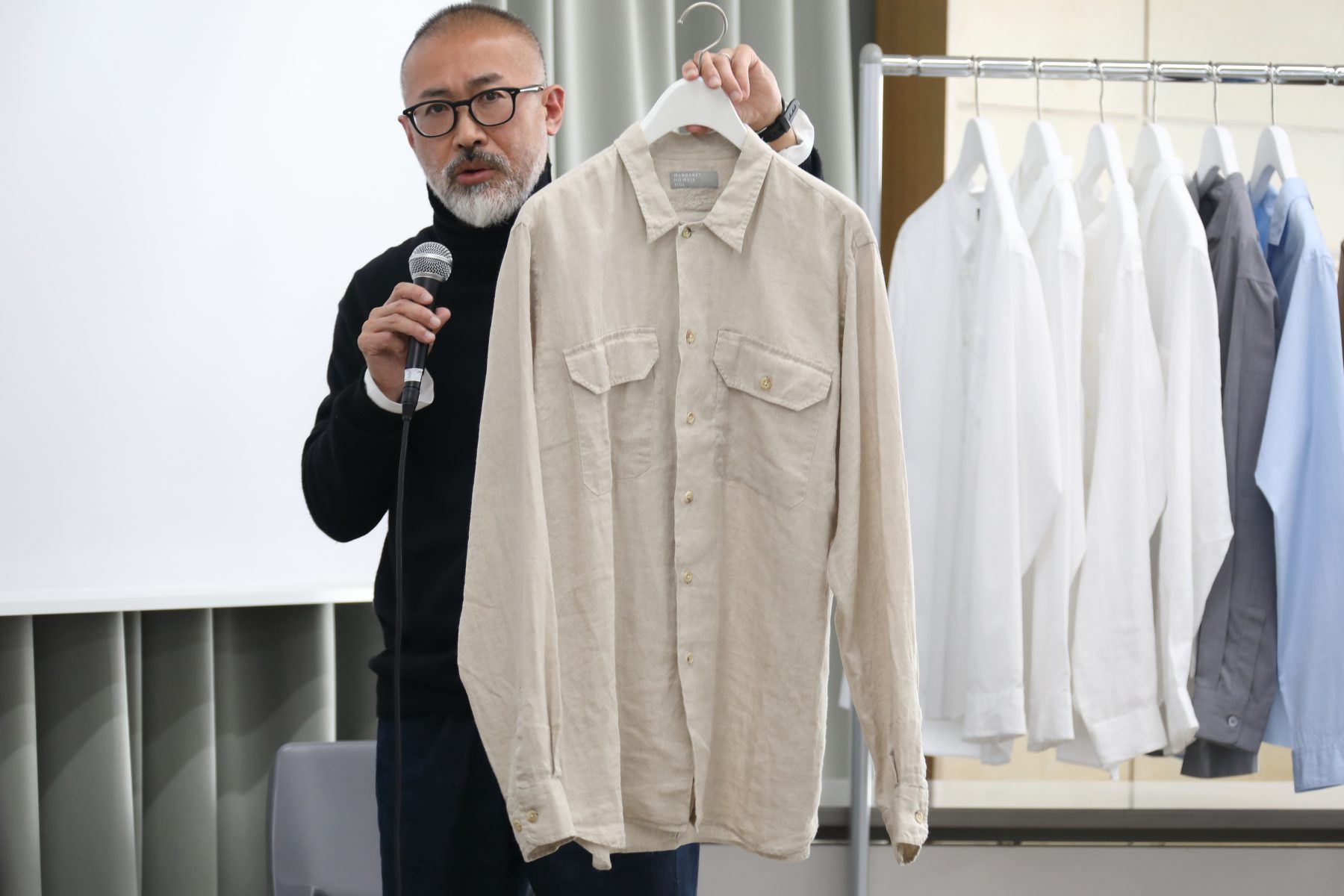
Regarding our motto of “Changing by Remaining Unchanged,” thinking beyond the line that connects the dots is important. Each dot here represents a clothing item. In our design team, we don’t have anyone specializing in one area, such as accessories, knitting, shirts, and so on. Instead, all of us in the team design together from the hat on the head to the socks on the feet. When we design, we concentrate on one item and consider its functionality, the beauty of its finish, and whether or not it represents the essence of Margaret Howell as a brand. Connecting these dots that are shirts, jackets, trousers, socks, and so on with a line, we examine if there are exciting movements and a balance between them that is unique to Margaret Howell. Incorporating a sense of time and mood into the overall balance of clothing perhaps constitutes Margaret Howell’s “way of changing.”
Session 2
Dialogue: Kenichi Ikeda (Margaret Howell) and Takahiro Yagi (Kaikado)
Takahiro Yagi
Founded in 1875 (Meiji8), Kaikado is a long-established maker of handmade tea caddies with the longest history in Japan. Takahiro Yagi, the sixth-generation successor, is actively cultivating overseas markets while continuing to develop its presence in the fields of design and interior design. Exploring new possibilities for traditional crafts through collaboration with other fields, Yagi launched the project “GO ON” in 2012 together with young successors of traditional crafts in Kyoto who are his contemporaries. Since 2018, Yagi has been a Special Research Fellow at the Center for Innovation in Traditional Industries at Kyoto Seika University.
Yagi: The idea that the wearer is central resonates with our idea of craftsmanship
Nishitani: When did Kaikado and Margaret Howell meet each other?
Yagi: Without us realizing it, Margaret had a portable tea caddy made by my father, which had been given to her as a gift by her friend. And in 2008, I had an opportunity to give a demonstration at Margaret Howell’s flagship store in Wigmore, London, and that led Margaret Howell to start retailing our products. At that time, I was very happy and excited about the prospect of making a Kaikado tea caddy for Margaret Howell, imagining what kind of model I would create. But the person in charge said to me: “Margaret says she likes Kaikado’s products the way they are.” (laughs) As much as I was disappointed, I was also happy that Margaret wholeheartedly approves of Kaikado’s products.
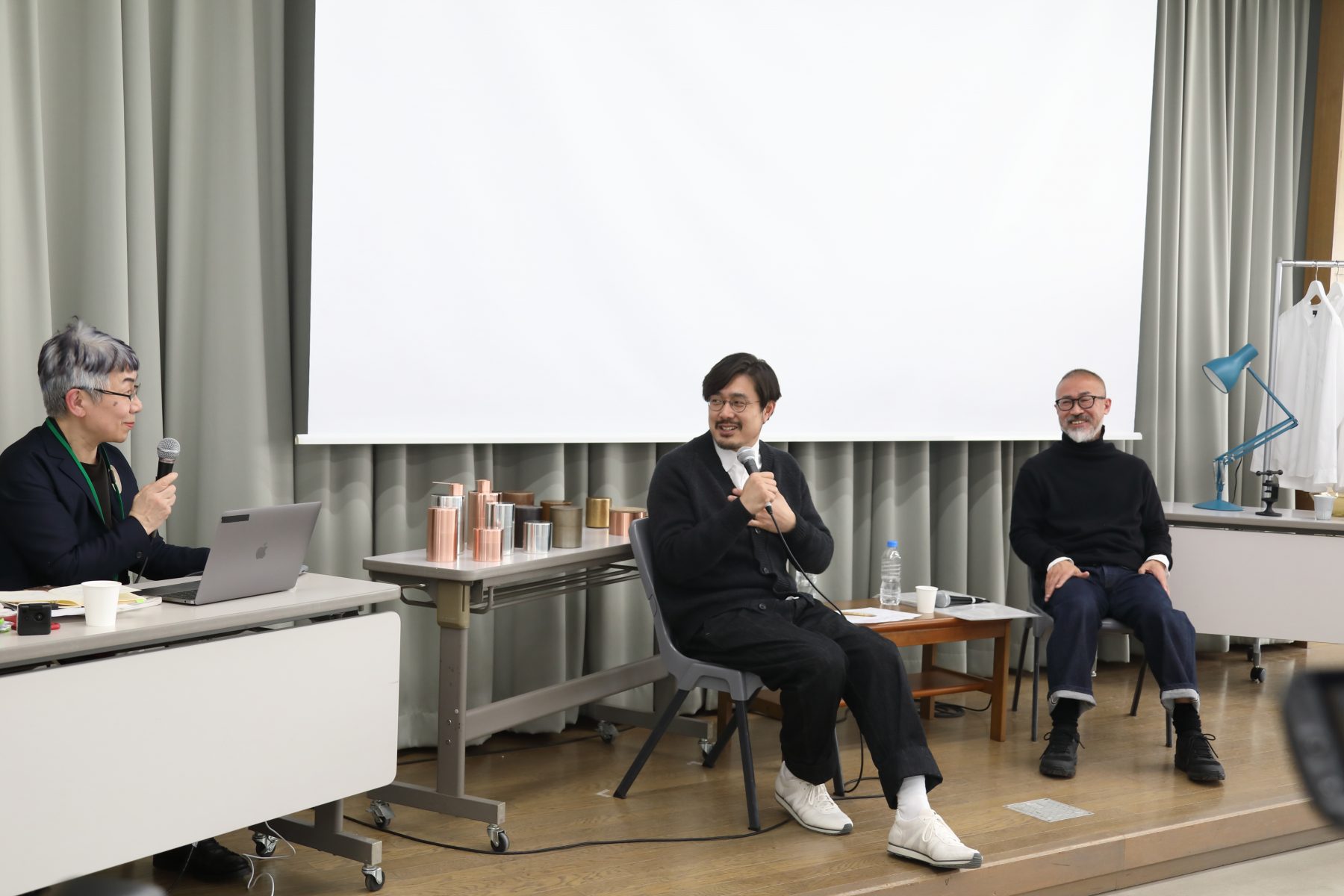
Ikeda: You have been wearing Margaret Howell’s clothing for a long time, right?
Yagi: Yes. When it comes to Margaret Howell clothing, I can wear it every day to work. I work with metal and wooden mallets every day, and I feel like I can wear Margaret Howell garments in the same way I hold these tools. And yet, the clothes are good enough that I can present myself if a customer comes into the shop. That’s why I wear Margaret Howell clothing all the time at work.
Ikeda: Margaret is a busy person and constantly on the move. That’s why we don’t make heels or pumps, and designing clothes that are comfortable to move around is the foundation of Margaret Howell. The clothes we design should be comfortable in daily life and give you a sense of ease, becoming a part of your skin before you know it. In this respect, Margaret Howell garments resemble the tools that are always close at hand, like the hammer Yagi talked about.
Yagi: I think Margaret Howell’s ideas about quality and materials, which Ikeda previously described, resemble the way we feel when making products. My impression is that Margaret’s clothes are everyday products of a high quality, not something you wear for a special occasion. Because this aspect seems to be highly valued by the brand, there is a moment when I suddenly feel a sense of joy when wearing them. Margaret is a person who doesn’t even show up for special occasions such as fashion shows, right? (laughs) Her idea that the clothing she makes is integral, and the wearer is central resonates with how we think as craftsmen.
Ikeda: It doesn’t look drastically different at first glance, but it has changed. This might be similar to the action of pruning bonsai
Ikeda: Kaikado’s tea caddies don’t embody glamorous design, but you pay careful attention to the details that are not visible. For example, the way the lid slides off smoothly is a design feature that makes you feel good. In our case, the stitch is an equivalent feature. I think the essence of design lies in such invisible elements.
Yagi: Certainly, if something doesn’t function well, you feel disappointed when using it. That’s also the point I usually pay attention to when choosing a product as a consumer. Craftsmanship is about pursuing these details over generations. The fact that we continue to make the same product gives us a chance to thoroughly observe the details. Even from our standpoint as craftsmen, I think what Margaret has been doing over the years very much resembles craftsmanship, and she probably embodies craftsmanship more than a regular craftsman. By the way, in the lecture, you mentioned that the brand adds playful elements to the unchanged material, but if it goes too far then it approaches fashion. Is there some kind of balance that prevents you from going too far?
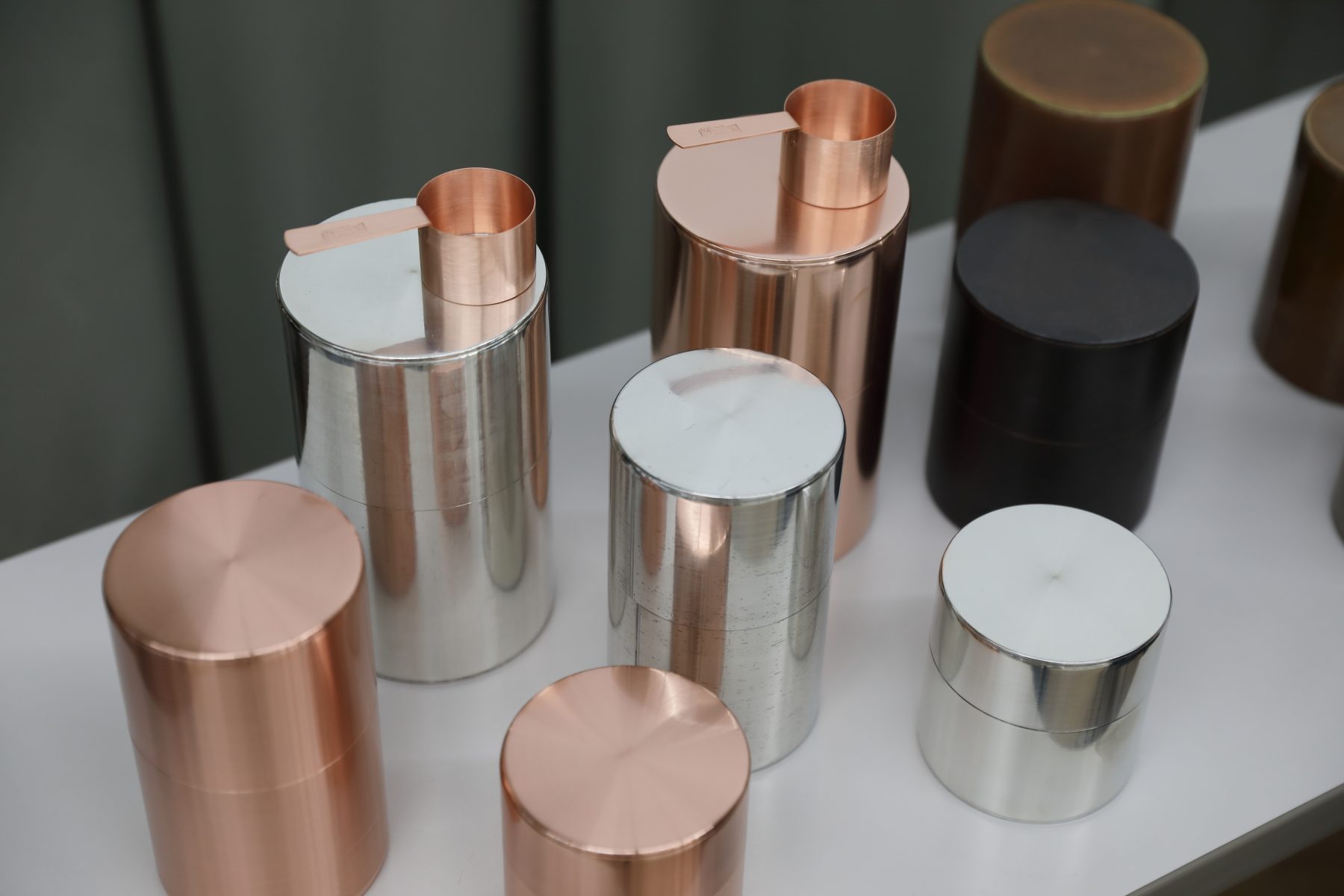
Ikeda: This brand is an expression of Margaret’s lifestyle, and while her lifestyle is universal, this doesn’t mean that it remains unchanged. We have fun adding new essence to the unchanging core. I don’t think Margaret herself is aware of that prescription, but the staff designers around her sometimes go too far. And this is where Margaret steps in to supervise. To give you a rough idea, let’s say we are making the same shirt, and she increases a button’s size a little or adds an extra one. Even such small changes do shift the appearance of the garment. This might be comparable to pruning a bonsai. It looks the same at first glance, but one experiences joy when noticing that a branch has been trimmed. And it is this feeling of achievement when someone notices our work that I enjoy personally.
Yagi: Margaret said to me, “You don’t have to change anything,” and this comment served as a turning point when I succeeded the family business
Ikeda: As mentioned before, when Margaret Howell started selling Kaikado’s products, you were wondering if you would receive any design requests based on her taste. But Margaret told you she likes Kaikdado’s products the way they are. That episode seems most characteristic of Margaret, doesn’t it?
Yagi: It was a compliment that she recognizes the quality of our products, and she seemed to imply, “Kaikado is fine just the way it is, so don’t add anything extra.” And that made my back straighten. Around that time, I started making coffee caddies and various other things, and a sense of “I” instead of “we” was emerging through a growing desire to add something to the work of my predecessors. But I felt like I was being told, “No no, the way Kaikado has been making products all these years is good enough.” (laughs) That comment served as one of the turning points for me to succeed in this job.
Ikeda: If Margaret had made various requests at that time, Kaikado might be different today, right?
Yagi: Certainly. After that, I came to consider what characterizes Kaikado. For example, the sense of satisfaction lies in the unchanged vertical and horizontal ratio of the tea caddies that we have traditionally made. I was able to revisit the work of my father and grandfather. By the way, during the era of my grandfather, Kaikado momentarily shortened the lid, but poor sales led us to revert back again. It’s not unlike the example of buttons you described earlier, where the appearance changes greatly with only the slightest alteration.
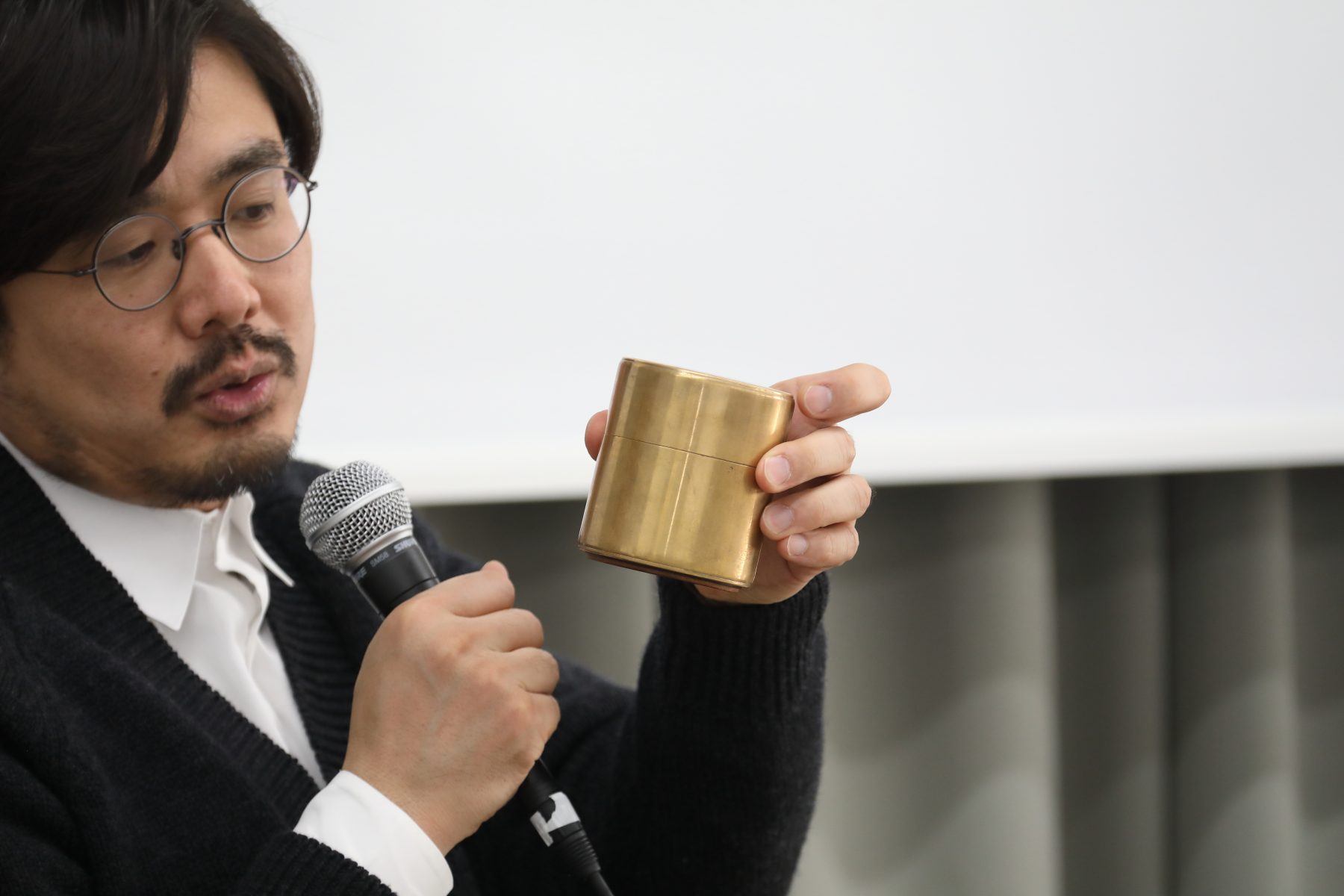
Ikeda: When I took a walk with Margaret on the beach, she indicated, “This is what I’m trying to say” while picking up driftwood and stones
Ikeda: Color is one of the characteristics that define Margaret’s design work. Her choice of color is truly unique. We think it’s important to find and notice the colors that we cannot express in words. Three or four years ago, I walked with Margaret along the beach that was seen in the opening short film. As we walked, there were pieces of driftwood and stones lying on the beach. Margaret showed me the shades on a piece of driftwood where the paint had peeled off possibly after hitting something, and on a stone that had weathered after a long journey. And she indicated, “This is what I’m trying to say.” She also added, “ I wonder if Japanese members of staff would understand this sensibility.” When a tweed jacket fades due to sun exposure and changes color over the years, it adds character to the jacket and heightens its appeal. This is what she was trying to convey.
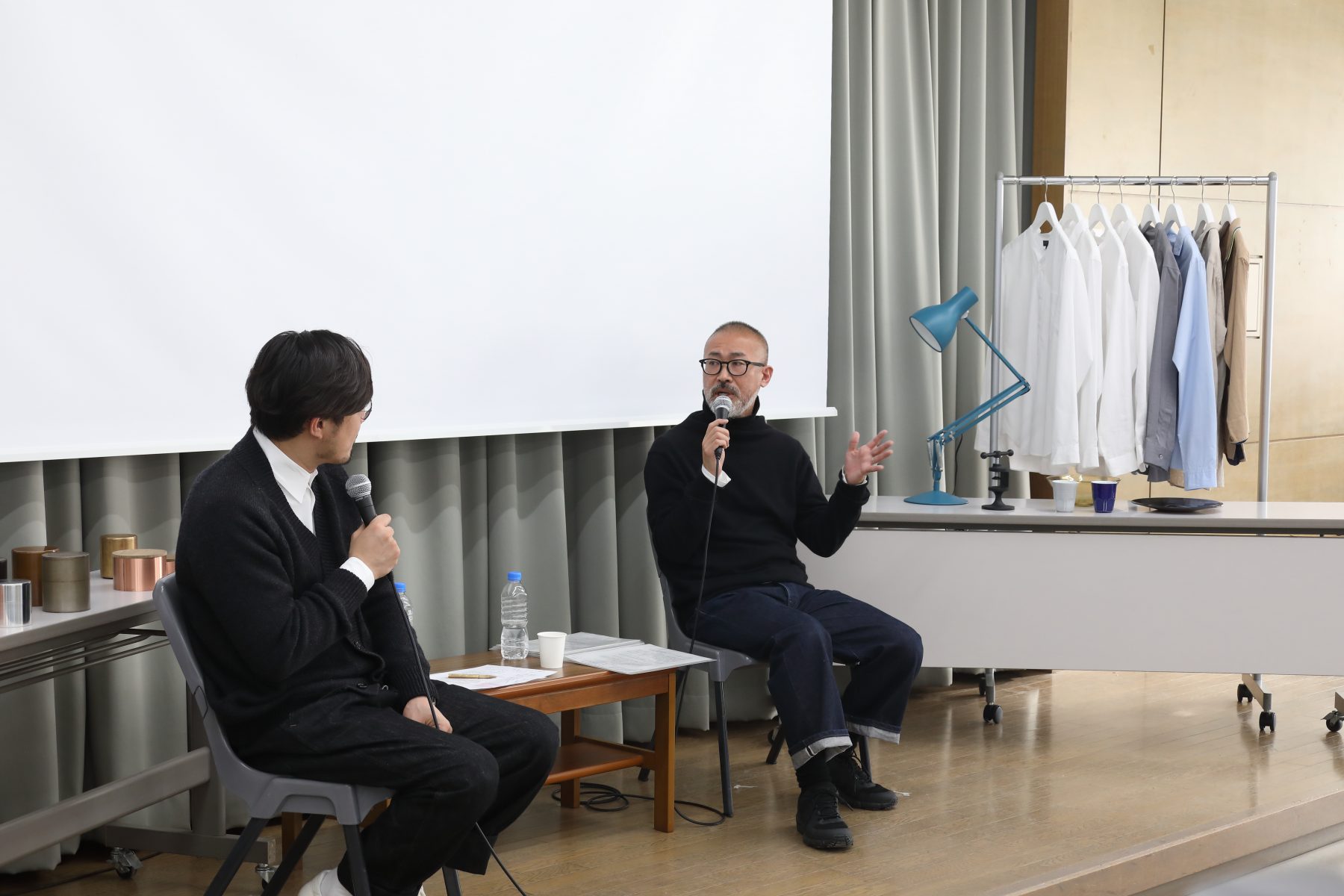
Yagi: As a worker, do you find comfort in not changing?
Ikeda: I do want people to feel newness every season. At the same time, when a customer buys a new item and takes it home, it shouldn’t look like a newcomer but instead fit nicely in the closet as if it had always been there. And when the next season arrives, customers can still enjoy the size and color of the item with the mood of a new season even if the item comes from a previous season. That’s what Margaret and we the team are aiming for in each season.
Yagi: What about the materials that age such as Harris tweed?
Ikeda: Basically, we like tough materials, but in a way clothing made with such materials doesn’t look good when purchased. The reason is that as the customer continues to wear it, the garment comes to fit the style of the wearer and adapts to their body shape and habits. We instruct our shop staff about that.
Yagi: That’s an essential part of craftsmanship, isn’t it? Our products are used not just by one but multiple generations, and we sometimes offer custom-made repair work, which means that when designing we think about the aspects that we can possibly customize for an individual user. When it comes to fashion designers, there are people who value expressing who they are, but once again Margaret Howell focuses on the wearer as the central character in its creation.
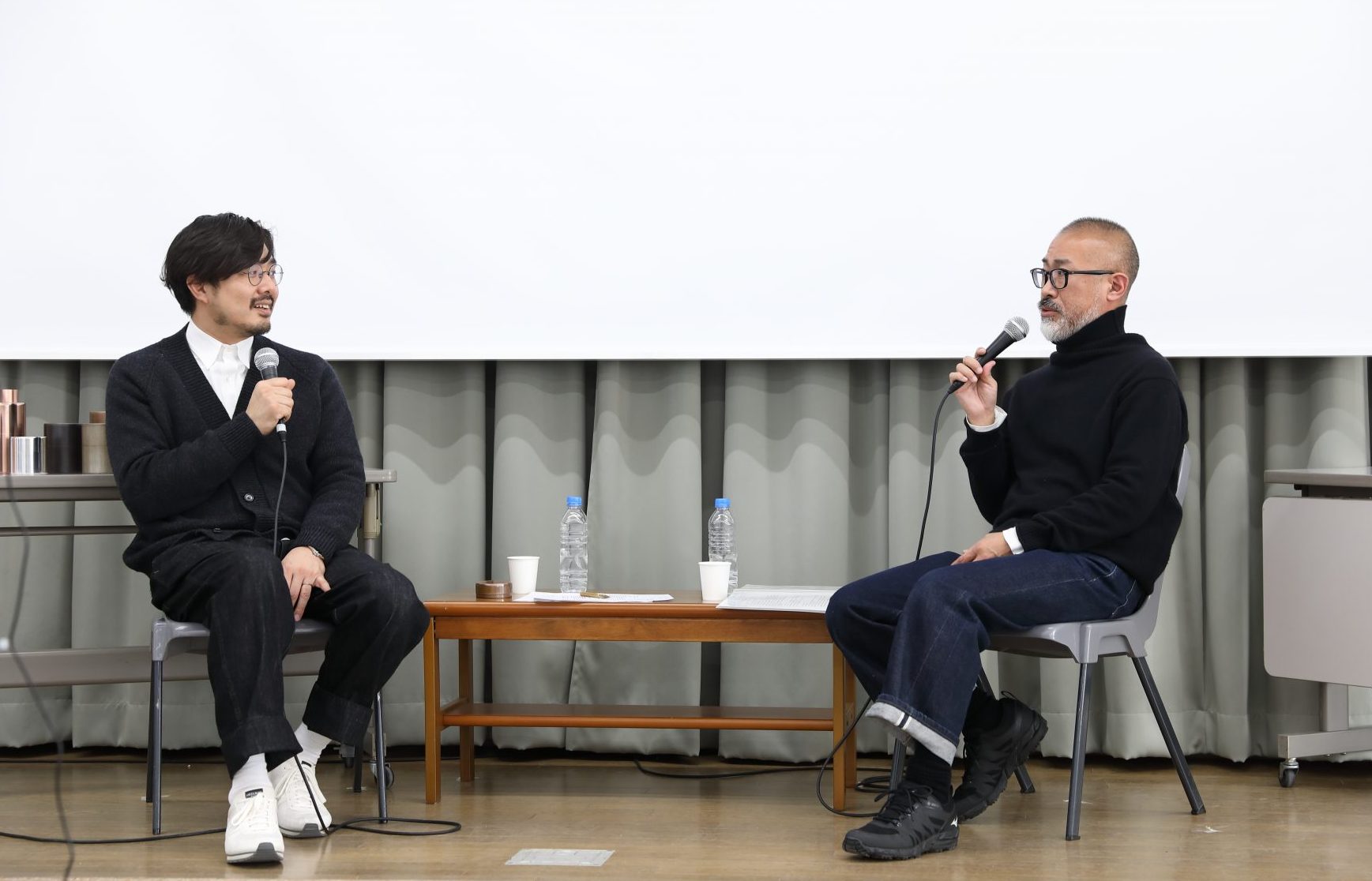
Ikeda: From paper to digital. Precisely because times change, we endeavor to demonstrate “a way of changing by remaining unchanged”
Yagi: As online interactions increase in various ways in the near future, we will be unable to convey a sense of comfort that can be understood only through touch. When it comes to a shirt, there is a sense of comfort you notice only after wearing it, but how can you communicate that?
Ikeda: That’s the challenge we must take on. How can we engage the senses through digital formats? What can we do to trigger peoples’ interest? Regarding our approach, by showcasing the process of making products online, we invite people to understand our philosophy, and hopefully they take an interest in how we make our products and are encouraged to touch and see them in person.
Yagi: It’s difficult, isn’t it?
Ikeda: Undoubtedly, but it’s also interesting because we haven’t done it before. If we can show what is in the background, such as the factory where needlework is done or where various items like thread and fabric are made rather than just selling finished clothing in shops, this will help customers to understand how carefully we make products. There is a meaning behind why we as Margaret Howell “change by remaining unchanged.” It sounds exaggerated, but I think this is our mission.
Yagi: Sites for making continue to exist. How do we convey that and adapt it to the present era?
Ikeda: Speaking about that, since there are many students attending this event, I would like to offer you one message. When I was a student, wearing high-end fashion brands was a trend in Japan. I used to change my clothes just to go out at night. I discovered my own style in the process of trying out various clothes including Japanese, American and European fashion brands, as well as used clothing. At that time, I really liked British fashion and I was wearing British style clothing in my own way, but when I started working with Margaret, I realized that I had misunderstood British style. (laughs) My understanding of British style was to wear a smart suit and dress up from head to toes. But when I saw people at Margaret’s atelier enjoying relaxed, natural, and comfortable lifestyles, I found it wonderful. I was able to fully appreciate how excellent Margaret’s clothing is precisely because I graduated from a vocational school in the 1980s, experienced various fashion jobs, and tried out different types of clothes. Today, I had a chance to see the graduation exhibition of Kyoto Seika University, and what came to mind again is that students should try whatever interests them while they are young. If you continue to pursue your interest, you will better understand what makes you feel comfortable and what you believe in. But it’s hard to imagine yourself without branches and leaves unless you first take on challenges. That’s why I want you to try many different things. You don’t have to aim for the simplicity of Kaikado from the beginning. (laughs) I myself was able to learn the virtues of comfort and composure from Margaret Howell by experiencing various fashion jobs.
Session 3
Message from Margaret Howell to the Students of Kyoto Seika University
Part 1 Answers to Student Questions
Q. I am searching for my own design style that will help me survive in this industry. Do you have any suggestions as to how I can find it? I really want to find my own style.
Your own style comes from what interests you. Perhaps you could look at the graphic work of an artist that appeals to you and think why you like their work. Is it the color? Shape? Realism? Abstraction? Or scale? Then, mix some of these elements up, and you might find something fresh that will guide you into a unique style of your own. Feel free to experiment. Your style should express what you feel.
Q. Do you have any regrets about things you wish you had done while a student?
Yes. Looking back now, I should probably have followed a different discipline other than painting and fine art after my first year at college. In my first year, we were set various projects using different mediums. For example printmaking, sculpture, and construction, life drawing. I enjoyed working to a brief, which is a good preparation for a career in design. But the next three years concentrated on painting, a time when most students were interested in abstract painting, which I didn’t relate to at that time. Basically I felt lost. In hindsight, I should have continued to paint realistically and not be intimidated by the large-scale paintings of students around me.
Q. What kind of difficulties did you experience at the beginning of your international career?
Leaving college and getting started was the biggest hurdle. I didn’t have grand ideas, I just wanted to do something creative and to earn my living. From an early age I loved making things, and when I had little success trying to get work after leaving college, I started to make accessories. Small items that I could show to shop buyers. For example, knitted hats, handmade beads, necklaces, and bracelets. When a boutique actually bought some from me I realized that I could make something I liked and sell it to people who valued it as well. So having made my own clothes and enjoyed the craft of making a shirt, say, why not develop that? It was something I could do and I could organize others to do for me. When I took on machinists to work for me, I learned a lot from their expertise. And that’s how it started. I was ambitious, but not for big business or wealth.
Q. What level of experience, knowledge, and skills do you think is enough for an undergraduate student to have the confidence to start working worldwide?
An undergraduate is unlikely to have international experience, so work with your knowledge and skills, but also develop things you enjoy doing for their own sake. My break came from something most people would call a hobby. Be ready to recognize an opportunity when it appears. I have been lucky with the people I work with and very much so in Japan, where an experienced entrepreneur understood what I was trying to do and wanted to work with me. Together, we presented my style to a different culture without compromising the integrity of design. Being able to find the right person to trust is as important as trusting your own talent. Trust your own judgment about people you choose to work with. Success means scaling up the production of range and volume, which inevitably poses problems. Experience is gained through facing such problems with trusted colleagues.
Q. While utilizing classical and traditional materials, your work looks very modern. What inspired you to create this kind of modern style?
I owe a lot to my parents. Our family values and lifestyle. A love nature and the outdoors, an active lifestyle. Walking and sport. My mother was interested in the quality of clothes and natural materials. My parents were not wealthy, but saved up to buy good quality products. We were taught to look after things. As a teenager, I was interested in the fashion pages, but for myself I dressed more conservatively. I was drawn more to functional clothing. I admired designers like Yves Saint Laurent’s trouser suits for women. The style of Katharine Hepburn and Jane Birkin, and the French style anglais of girls wearing men’s jackets with jeans. Without realizing it at the time, I was connecting with a set of aesthetic and practical values that would become my style.
Q. Why does your work never look old-fashioned? Can you please share the things that you pay particular attention to?
So when the time came to make clothes professionally, I worked with classics I already admired. But I always wanted to make subtle changes to the classics. Bigger, longer, softer construction. Bring them up to date for a modern lifestyle – a look complemented by flat-heeled shoes. These changes were intuitive for me. I find it hard to say why. It is a feeling for volume and proportion, and sometimes color combinations look fresh and feel right, and details just seem to belong, the way you tie a scarf or wear a belt.
Q. When did you realize that what you were marking constitutes your style?
In the beginning I didn’t consciously think what I was doing would be seen as a style. I used to make my own clothes because I knew what I wanted, but couldn’t always find it in the shops. I was also inspired by good quality in make as well as fabric, so I aspired to the quality of certain established British manufacturers. For example in the 1970s, Burberry, Mackintosh, John Smedley, and Tricker’s shoes, and Scottish cashmere and knitwear. But I wanted to work with the manufactures to make subtle changes. So it was probably ten years after starting out to make shirts, then a jacket, trousers, a raincoat, that I increased the range of my design to include a whole wardrobe. What was distinctive about my style was not just the cut and casual, relaxed feel of the clothes, together with quality of make, but also an equality of clothing. They were men’s clothes that women also wanted to buy. That appealed to my generation and reflected their changing lifestyle. Like me, they may have been impressed by the creative explosion of 1960s fashion, but not necessarily wanted to wear it. They wanted good, wearable design, not trend for its own sake.
Q. What do you do to further refine your design?
I tried to find the right fabric for the function and character of the garment, to keep an eye on detail and proportions. As I said, I think I have an intuitive feel for what sort of fit and length and other features are right for any one time.
Q. I assume that you design clothes in ways that pay close attention to material, comfort, and usability. When you were a university student, did you take these into consideration with the clothes that you bought or owned?
Yes, as a student I aspired to one of Cacharel’s beautiful shirts for women. A Shetland wool crewneck sweater. And an expensive pair of leather brogues. I had to save up to buy these pieces, but the fact I remember them shows that I loved them and aspired to own things with that quality and style. At the same time, I would wear Levi’s jeans, Plimsolls, Dungarees, and French indigo farmers jackets, and go to jumble sales for vintage clothes and objects, always on the hunt for something unique rather than one of the many to be found on the rails in shops.
Q. When I am working on an assignment, I find it difficult to have confidence in my work because the designs of my peers appear better than mine. What can I do to gain confidence in my designs?
I think we all feel like this sometimes, and maybe make mistakes sometimes. Remember, those who start first don’t always finish first. Instead of comparing yourself with your peers, find examples of design in your medium that you do not like, ask yourself why you don’t like it, and that will help you to explore your own values and what matters to you. If you engage with something, you will be inspired. That should help you develop your work and launch it into the real world.
Q. MHL’s women’s line seems to encompass a masculine element. Do you pay attention to gender differences when designing?
Yes. Many functional styles can cross over with changes, mainly in terms of fabric and fit, and proportion. Sometimes color.
Q. What do you think constitutes “feminine” and “masculine” today, when diverse values are gaining acceptance?
I don’t really think about it. Looking back over my answers, I hope it’s clear that I make clothes rather than statements. When I meet someone I’m more interested in their character and abilities rather than the category they might belong to. I suppose I’ve always felt equal, having gone to a mixed school in the progressive 1960s. When we were teenagers, my sister and I gave each other very short razor haircuts and we would get comments like, “Is that a boy or a girl?” And we thought, “So what? – What does it matter?”
Part 2 Message to the students
I’m honored to have been invited to answer your questions, and I hope they will be helpful for you. A creative worker must find their own path, and learn to trust themselves while always being open to learning. And to recognize there is always much to learn from others, even if only by challenging them. I wish you all the best for your careers.
Center for Innovation in Traditional Industries, Kyoto Seika University
This event has been funded in part by MEXT's "Private University Research Branding Project" subsidies.
Cooperation: TSI Inc. (formerly anglobal Inc.) / Kaikado Inc.
Photography: Natsuko Ishikawa
Text: Toyo KIN
Translation: hanare x Social Kitchen Translation